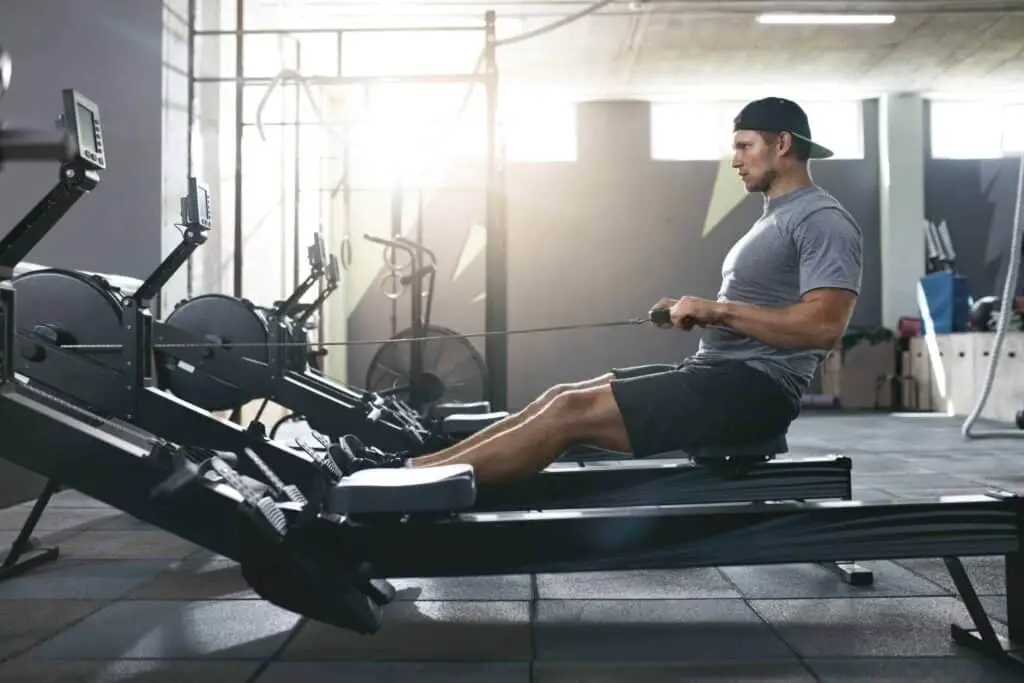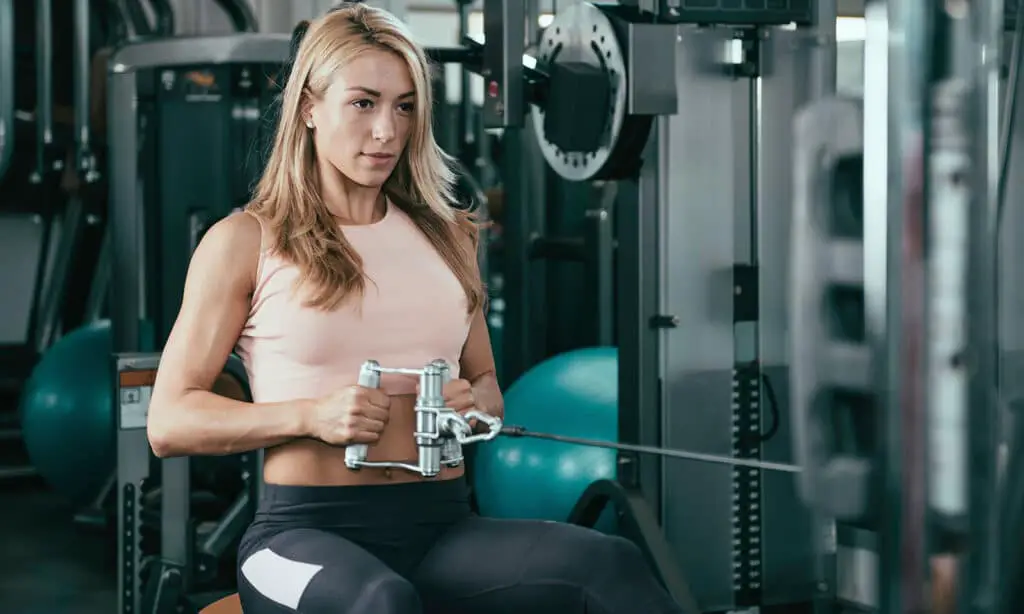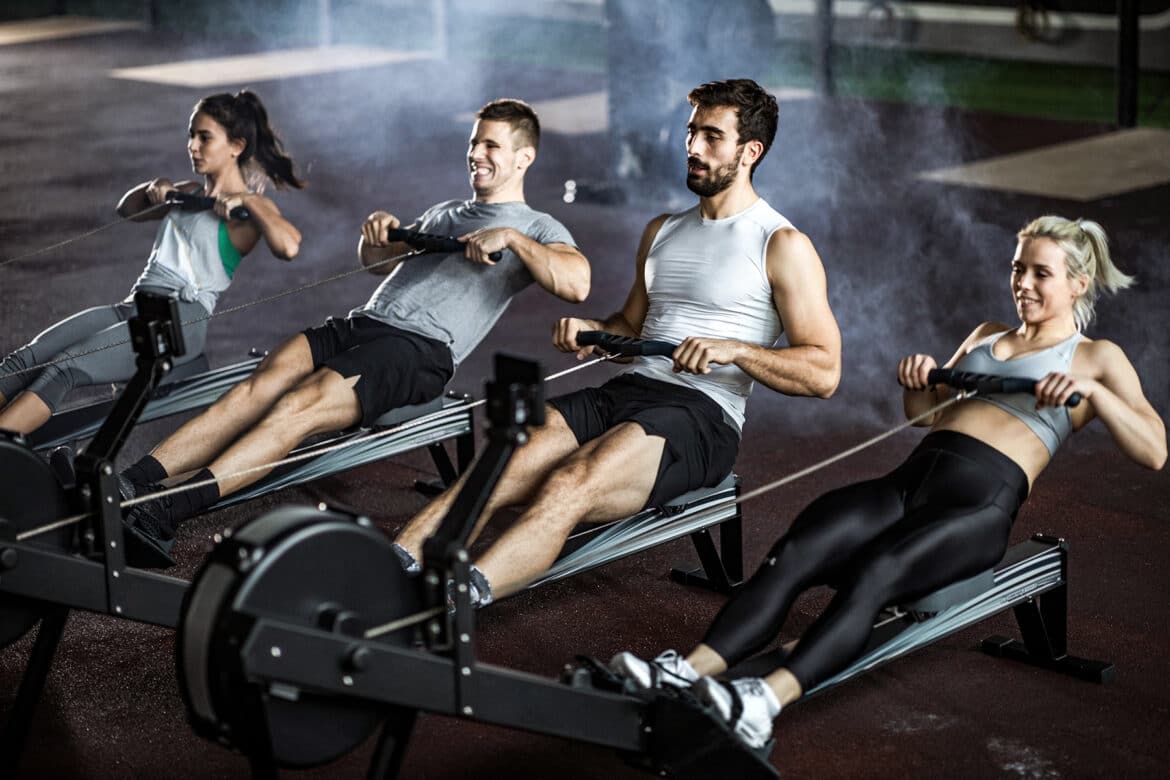Introduction
Is Rowing Strength Training: Rowing is a dynamic and physically demanding sport that engages virtually every major muscle group in the body. While it is primarily known as a cardiovascular activity that promotes endurance and aerobic fitness, it also offers significant benefits as a form of strength training. In this discussion, we will explore the multifaceted nature of rowing and delve into how it can serve as a potent means of building and enhancing muscular strength. From the powerful leg drive to the core-strengthening motion of the rowing stroke, rowing transcends its reputation as a pure endurance sport to emerge as a comprehensive strength training regimen. So, let’s take a closer look at whether rowing can be considered a form of strength training and the physical attributes it can help develop.
Rowing starts with a powerful leg drive. Pushing against the footrests generates force through the legs, working the quadriceps, hamstrings, and calf muscles. This leg power is essential for propelling the boat or rowing machine. Maintaining proper rowing technique requires a strong and stable core. The abdominal muscles, obliques, and lower back muscles are all actively engaged to stabilize the body and transfer power from the legs to the oar or handle.
The pulling phase of the rowing stroke heavily engages the muscles of the upper back, including the latissimus dorsi and trapezius, as well as the rear deltoids and biceps. This motion is crucial for developing upper body strength.While rowing predominantly relies on the larger muscle groups in the legs, back, and core, the arms still play a role in the stroke. The forearm and grip strength are essential for maintaining control and power during the pull.

Can rowing replace strength training?
Muscle building
A rowing machine can improve endurance and strengthen muscles, whereas lifting weights is primarily used to build muscles in a short period. Lifting weights is considered better for growing specific muscles, but rowing is better for an all-over, full-body workout.
The Strengths of Rowing as a Form of Exercise
Comprehensive Muscle Engagement: Rowing is a dynamic exercise that recruits muscles throughout the body. It emphasizes the legs, core, back, and arms, making it a potent full-body workout. This comprehensive engagement contributes to overall strength development.
Cardiovascular Fitness: Rowing is exceptional for cardiovascular conditioning. It elevates heart rate, burns calories, and improves lung capacity, which is crucial for overall health.
Low-Impact Exercise: Unlike high-impact activities like running or jumping, rowing is low-impact. This makes it a suitable choice for individuals with joint issues or those seeking a less stressful workout on their bodies.
Functional Strength: Rowing simulates real-life movements, such as pushing and pulling. This functional aspect can translate into improved strength and coordination in daily activities.
Limitations of Rowing as a Sole Strength Training Method
Lack of Specificity: Rowing primarily develops muscular endurance, not maximal strength. Strength training typically involves lifting heavier weights with fewer repetitions to build muscle mass and raw strength. Rowing may not provide the necessary stimulus for maximal strength gains.
Neglecting Certain Muscle Groups: While rowing engages a wide array of muscles, it may not adequately target some specific muscle groups, such as the chest or certain smaller stabilizer muscles. Traditional strength training exercises can address these areas more directly.
Plateauing: Over time, the body adapts to a repetitive exercise routine. If rowing is the sole form of exercise, individuals may experience diminishing returns in terms of strength and muscle development.
Variety: A well-rounded fitness routine should incorporate a variety of exercises to address different fitness components. Rowing alone may not provide the variety needed to optimize overall fitness.
Is rowing enough strength training?
Rowing is one of the few workouts that can provide both cardio and strength training in one, making it the best of both worlds. This full-body workout provides a low-impact, high-intensity workout that increases cardiovascular endurance while also building muscular strength and endurance.
The Strengths of Rowing as a Form of Exercise
Full-Body Workout: Rowing is renowned for its ability to work nearly every major muscle group in the body. It emphasizes the legs, back, core, and arms, providing a comprehensive full-body workout.
Cardiovascular Benefits: Rowing elevates the heart rate and promotes cardiovascular fitness. It can help improve endurance, stamina, and lung capacity, making it an excellent choice for overall health.
Low-Impact Nature: Rowing is a low-impact exercise, which means it places less stress on the joints compared to activities like running or jumping. This makes it suitable for individuals with joint issues or those seeking a gentler form of exercise.
Functional Strength: Rowing simulates real-life movements involving pushing and pulling, which can contribute to functional strength and improved coordination.
Limitations of Rowing for Strength Training
Muscle Hypertrophy: Rowing primarily develops muscular endurance rather than muscle hypertrophy (increasing muscle size). Traditional strength training, which involves lifting heavier weights with fewer repetitions, is more effective for building significant muscle mass.
Maximal Strength: Rowing may not provide the necessary stimulus for maximal strength gains. Exercises like squats, deadlifts, and bench presses are better suited for developing maximal strength.
Muscle Imbalances: Rowing emphasizes some muscle groups more than others. For instance, it works the legs and back extensively but may not target the chest or specific smaller muscle groups as effectively.
Variety: A well-rounded fitness routine should incorporate a variety of exercises to address different aspects of fitness, such as flexibility, mobility, and explosive power. Relying solely on rowing may neglect these important components.
Does rowing build strength?
Since rowing engages all of your major muscle groups during each stroke, it is an extremely effective way to gain muscle mass. Rowing provides a full-body workout, and can help you strengthen and build muscles in your upper body, lower body, and your core.
Comprehensive Muscle Engagement: Rowing is a full-body workout that engages multiple muscle groups simultaneously. The rowing stroke involves the legs, core, back, and arms, creating a holistic approach to strength development. Here’s how each muscle group is involved:
Legs: The initial phase of the rowing stroke involves a powerful leg drive, which engages the quadriceps, hamstrings, and calf muscles. This leg power is essential for generating force.
Core: The core muscles, including the abdominals, obliques, and lower back, play a critical role in stabilizing the body during the rowing motion. A strong core is necessary for maintaining proper form and transferring power effectively.
Back: The pulling phase of the stroke activates the muscles of the upper back, specifically the latissimus dorsi and trapezius. This motion helps improve upper body strength.
Arms: While the arms play a role in the rowing stroke, they are not the primary source of power. Nonetheless, they still contribute to overall upper body strength, particularly the forearm and grip muscles.
Muscular Endurance: Rowing is an endurance-focused activity, and repeated rowing sessions help build muscular endurance. This means that your muscles become better at sustaining effort over extended periods, which can be beneficial for activities requiring prolonged strength and stamina.
Functional Strength: Rowing’s emphasis on real-life movements, such as pushing and pulling, contributes to functional strength. This type of strength is relevant to everyday activities and can enhance overall physical performance and coordination.
Low-Impact Nature: Rowing is a low-impact exercise, making it a suitable option for individuals with joint issues or those who prefer a gentler form of strength training. It reduces the risk of injury associated with high-impact activities.
Cardiovascular Benefits: Rowing also provides significant cardiovascular benefits, improving heart health and lung capacity. This cardiovascular conditioning is an essential component of overall fitness.
Is 20 minutes of rowing enough?
In short: if you’re working out for general health, using a rowing machine for 30 minutes a day at a moderate intensity, or 15 minutes a day at a vigorous intensity, is plenty. However, if you’re rowing for weight loss or sports training, you might need to do more — around 40 minutes a day.
Benefits of a 20-Minute Rowing Workout
Cardiovascular Health: A 20-minute rowing session, if performed with sufficient intensity, can significantly elevate your heart rate and provide cardiovascular benefits. It helps improve lung capacity, stamina, and overall cardiovascular fitness.
Calorie Burn: Rowing is a high-intensity, full-body workout that can burn a substantial number of calories in a short time. This makes it an effective choice for those seeking weight loss or calorie expenditure within a limited timeframe.
Time Efficiency: In our busy lives, finding time for exercise can be a challenge. A 20-minute rowing workout is a time-efficient option that allows you to fit exercise into your schedule.
Endurance and Stamina: Regular 20-minute rowing sessions can improve muscular endurance and overall stamina. This can be particularly beneficial for sports or activities that require sustained effort.
Limitations of a 20-Minute Rowing Workout
Strength Development: While rowing is a great cardio workout and builds endurance, it may not provide sufficient time or resistance to promote significant strength gains, especially in terms of maximal strength or muscle hypertrophy.
Variety and Comprehensive Fitness: Relying solely on 20-minute rowing workouts can neglect other aspects of fitness, such as flexibility, mobility, and the development of different muscle groups. A well-rounded fitness routine should incorporate a variety of exercises.
Fitness Goals: The effectiveness of a 20-minute rowing workout depends on your specific fitness goals. If you’re looking to build strength, you’ll likely need to supplement rowing with other forms of strength training.
Are rowers fitter than runners?
“In general, rowing builds muscle mass faster than running,” Elmardi says. One study found that rowing utilizes nearly 85 percent of the body’s muscles, while running is considered a lower-body exercise, meaning it uses fewer muscles overall, says Elmardi.
Fitness in Running
Running is renowned for its cardiovascular benefits and its ability to build endurance. Here are some key aspects of running fitness:
Cardiovascular Endurance: Runners typically excel in cardiovascular endurance, as this sport involves sustained aerobic activity over extended periods. Long-distance runners, in particular, develop exceptional endurance levels.
Calorie Burn: Running can burn a significant number of calories, making it an effective choice for weight management and fat loss.
Impact and Bone Health: While running is a high-impact activity, it can also contribute to improved bone density and overall musculoskeletal health.
Mental Toughness: Long-distance running requires mental fortitude and discipline, which can be considered a form of fitness in terms of mental resilience.
Fitness in Rowing
Rowing is a full-body, low-impact exercise that combines both strength and cardiovascular elements. Here are some key aspects of rowing fitness:
Full-Body Strength: Rowers often have excellent muscular strength, particularly in the legs, back, and core. The rowing stroke engages a wide range of muscle groups, contributing to overall strength.
Cardiovascular Fitness: Rowing provides cardiovascular benefits similar to running, as it elevates heart rate and improves lung capacity. Rowing machines can simulate different types of workouts, including high-intensity interval training (HIIT), which can enhance cardiovascular fitness.
Low Impact: Rowing is gentler on the joints than running, which can be advantageous for individuals with joint issues or those seeking a low-impact exercise option.
Functional Strength: The rowing motion mimics functional movements like pushing and pulling, contributing to practical, everyday strength.
Can rowing replace squats?
The benefits of rowing for leg muscles are similar to a squat, deadlift, or leg press. Again, you’re using low resistance and high reps here, so you likely won’t gain massive muscle. But if you stick with it, you’ll grow stronger, build endurance, and see a visible change in the shape and definition of your legs.
Benefits of Squats
Squats are a fundamental compound exercise that primarily targets the muscles of the lower body, including the quadriceps, hamstrings, glutes, and calves. They also engage the lower back, core, and upper body as stabilizer muscles. Here are some key advantages of squats:
Lower Body Strength: Squats are one of the most effective exercises for developing lower body strength and muscle mass. They can help you build powerful legs and a strong, toned lower body.
Functional Movement: Squats mimic everyday movements like sitting down and standing up, making them highly functional for daily activities.
Bone Density: Weight-bearing exercises like squats can help improve bone density, reducing the risk of osteoporosis.
Hormonal Response: Squats, especially when performed with heavy weights, stimulate the release of growth hormone and testosterone, which can support muscle growth.
Benefits of Rowing
Rowing, whether on the water or using a rowing machine (ergometer), is a full-body exercise that combines cardiovascular conditioning with muscular engagement. While it offers numerous advantages, its focus and strengths differ from those of squats:
Cardiovascular Fitness: Rowing is exceptional for cardiovascular fitness, improving heart and lung health, and enhancing endurance.
Full-Body Workout: Rowing engages various muscle groups, including the legs, core, back, and arms. It can help develop overall strength and functional fitness.
Low Impact: Rowing is gentler on the joints compared to high-impact exercises like running or jumping, making it suitable for individuals with joint issues.
Calorie Burn: Rowing can burn a substantial number of calories, aiding in weight management and fat loss.
Can you get a six pack from rowing?
Rowing Machine Abs Benefits – Rowing Machine King
Do Rowing Machines Benefit Abs? The answer to the question is without-a-doubt YES. A rowing machine benefits abs by constantly engaging the core throughout every rowing stroke and being a full-body fat burning workout. A person will not see their abs unless they get rid of the layer of fat on top of them!
The Role of Rowing in Abdominal Development
Core Engagement: Rowing requires a strong and stable core to maintain proper form and generate power throughout the stroke. As a result, rowing can help strengthen the core muscles, including the rectus abdominis (the “six-pack” muscles), obliques, and transverse abdominis.
Calorie Burn: Rowing is an effective calorie-burning exercise, which can contribute to overall fat loss. When combined with a balanced diet and regular exercise, rowing can help reduce body fat, making your abdominal muscles more visible.
Muscular Endurance: Rowing builds muscular endurance in the core, which can be beneficial for functional strength and posture.
Factors to Consider
Diet: Achieving a visible six-pack is not just about strengthening the muscles; it’s also about reducing body fat. You need a well-balanced diet with a caloric deficit (burning more calories than you consume) to shed excess body fat and reveal your abdominal muscles.
Genetics: Genetics play a significant role in how and where your body stores fat. Some individuals naturally have a leaner midsection and may find it easier to develop visible abdominal muscles, while others may need to work harder to achieve the same results.
Body Composition: Your overall body composition, including factors like muscle mass and body fat percentage, impacts the visibility of your abdominal muscles. Reducing body fat while maintaining or increasing muscle mass is key to achieving a six-pack.
Variety in Training: Rowing alone may not provide enough variety in abdominal muscle stimulation to fully develop a well-defined six-pack. Incorporating targeted ab exercises, such as planks, leg raises, and crunches, can help focus on this muscle group.
Consistency: Achieving a six-pack requires consistent effort in terms of both exercise and diet. Consistency is essential to seeing progress over time.
How long should I row for strength?
If you want to grow your muscles, it’s best to use your rowing machine for 30 minutes at least four times per week. There’s a common misconception that working out every day will lead to quick muscle growth, but rest days are crucial for those seeking more significant, more defined muscles.
Intensity Matters
The intensity of your rowing sessions is as crucial as duration. To maximize strength gains, incorporate high-intensity intervals (HIIT) into your rowing workouts. This involves short bursts of all-out effort followed by periods of active recovery. HIIT can help build strength and muscular power more effectively than steady-state rowing.
Frequency of Rowing Sessions
How often you row for strength also plays a significant role. It’s generally recommended to include rowing sessions in your routine 2 to 4 times per week, depending on your overall training plan and recovery capacity.
Complement with Strength Training
While rowing is an excellent full-body exercise that can contribute to strength development, it is usually not sufficient on its own, especially if you’re aiming for maximal strength or muscle hypertrophy. Consider combining rowing with traditional strength training exercises like squats, deadlifts, and bench presses for a well-rounded approach.
Listen to Your Body
Pay attention to how your body responds to rowing for strength. If you start to experience signs of overtraining or excessive fatigue, it may be a sign that you need to adjust the duration, intensity, or frequency of your rowing sessions.
Seek Professional Guidance
If you’re new to rowing or strength training, or if you have specific fitness goals, it’s advisable to seek guidance from a fitness professional or personal trainer. They can help you create a customized workout plan that aligns with your goals and ensures safe and effective training.

Conclusion
Rowing undeniably qualifies as a form of strength training. While it is renowned for its exceptional cardiovascular benefits and endurance-building qualities, it simultaneously provides a comprehensive workout for a multitude of muscle groups. From the explosive leg drive to the core stability required to maintain proper form and the substantial engagement of the upper body, rowing offers a holistic approach to strength development.
Moreover, its low-impact nature makes it accessible to a wide range of individuals, including those seeking an alternative to high-impact exercises or rehabilitating from injuries. The adaptability of rowing machines, with adjustable resistance levels, caters to individuals at various fitness levels, from beginners to advanced athletes.
Ultimately, rowing embodies the essence of functional strength training, where muscular power and endurance are harmoniously fused with cardiovascular fitness. Whether used as a standalone workout or integrated into a broader fitness routine, rowing is a versatile and effective means of enhancing one’s physical strength and overall well-being. So, for those looking to combine strength gains with cardiovascular conditioning, rowing is a valuable and rewarding option to consider.

